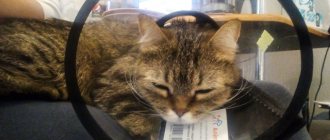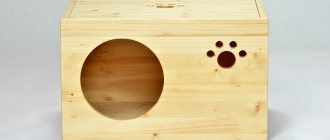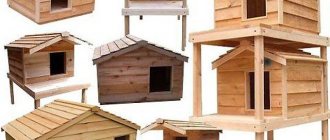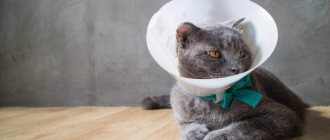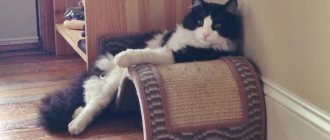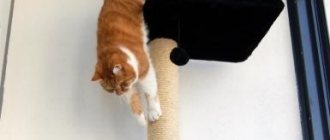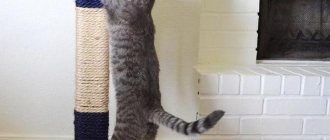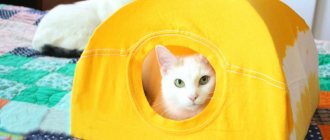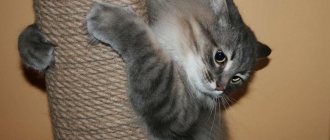The natural reflex of cats to lick their wounds in some situations harms them. Although this unique method of disinfection helps animals survive in the wild, it is not suitable for pets. There are more effective methods for disinfecting and healing wounds. But measures must be taken to prevent scratching and biting, which interfere with recovery. If you can protect a dog with a muzzle, then a veterinary collar will help a cat.
What is a protective collar for a cat?
A cat collar is usually referred to as a cone-shaped design. Other names are simpler - cone or cap. The design is made of durable material, narrowed on one side and larger in diameter on the other. This accessory is a popular tool in animal therapy using barrier structures.
A cat in protection will not be able to scratch unhealed wounds
The cap is used to protect and restrict access of a kitten or adult cat to areas of the body in the following cases:
- rehabilitation after castration;
- surgical interventions;
- processing wool with chemicals;
- recovery after abdominal surgery.
In all of these situations, the animal should not have even the slightest chance of scratching or gnawing wounds, or licking fur treated with chemicals. The main purpose of the barrier is to protect the animal and prevent it from harming itself.
When to use
Initially, the veterinary collar was a post-operative accessory, but the scope of the protective collar for cats has expanded over time. This means of barrier therapy is used both in a hospital hospital setting and at home.
When to use a collar
- After castration and sterilization operations, so that the animal does not lick the stitches, irritating the wound.
- After treating open wounds with ointments and powders to prevent the animal from licking them.
- During the course of treatment for ear mites, prevent your pet from scratching its ears.
- After treating the animal’s coat with antiparasitic agents: sprays, drops, shampoos. The cat will not be able to lick off the harmful medicine.
- If your pet is sick with lichen or another fungal disease and needs to treat the affected areas with antifungal ointments.
- After a fight or injury, if the cat needs treatment for scratches and wounds.
- In the postoperative period - after any abdominal surgery, injuries of the limbs and spine, traumatic brain injuries.
- During the treatment of allergic and infectious skin diseases.
- After eye surgery and time of treatment of ophthalmological diseases.
Why do you need a veterinary collar for cats?
This barrier protection product performs the following functions:
- Prevents the cat from removing post-operative dressings.
- Protects seams and open wounds from infection and injury.
- Allows medications (ointments, drops, powders) to be absorbed.
- Protects fastenings of metal structures in case of limb fractures.
- Prevents the licking of toxic medications (anti-parasitic drops).
- Protects the cat's head from scratches and scratches.
- Does not allow the bandage to be torn off from the head and eyes.
How long should you wear the collar?
The cat cone is used as prescribed by a veterinarian and is not removed from the animal until the wound has completely healed. Depending on the severity of the wound, the wearing period can range from several days to several weeks. During this period of time, the animal should not be allowed outside.
Wearing a special collar increases the effectiveness of many therapeutic measures and promotes a speedy recovery of the cat in the postoperative period.
In what cases is protection not needed?
Do-it-yourself collar for a dog after surgery
Freedom-loving animals have difficulty accepting a new wardrobe item. Therefore, if the pet cannot calm down, the veterinary cap will have to be removed.
There are times when completely getting rid of an accessory that is unpleasant for an animal is simply dangerous for its health. In such cases, it is necessary to replace the barrier structure with a bandage that is tied on the back. Animals perceive such a unique T-shirt more calmly.
A cat wearing a bandage feels more confident
Replacement option
If your pet does not want to put up with a device on his neck, you will have to buy or sew him a dress that will cover the wound.
Just keep in mind that this option is not suitable in all cases.
When treating wool and skin with various medications, you cannot do without a collar.
What to look for when choosing
A veterinary accessory significantly complicates the life of an animal, so its choice should be taken with full responsibility. Choosing a veterinary collar for a cat is quite difficult, since you need to take into account many nuances.
House for a cat: options for how to make it yourself
The part of the product adjacent to the neck should be soft, ideally covered with fabric. The height of the cone should not be too high so as not to interfere with the view. However, a low one will not work, otherwise it will lose its functionality.
Additional Information! Size is the most important criterion. The kitten should not remove the product easily. But it is worth considering that a narrow collar will put pressure on the neck. A product that holds its shape well is considered good.
Tools and materials
Nothing fancy is required. It is enough to have a plastic cloth, a sharp knife, a felt-tip pen and tape on hand.
In order not to make a mistake with the dimensions, you should make a pattern, and for this prepare:
- A sheet of paper (a double piece of paper from a school notebook);
- Ruler;
- Pencil;
- Compass;
- Centimeter.
Size chart of protective collars for cats - table
The big advantage of this category of veterinary product is that it can be selected in size according to the parameters of the animal. The following table will help you buy the right barrier cap:
How to make a house for a cat with your own hands: patterns
| Neck circumference (cm) | Collar height (cm) | Marking number |
| 22-25 | 7 | 7 |
| 22-25 | 10 | 10 |
| 28-33 | 12 | 12 |
| 31-38 | 15 | 15 |
| 38-44 | 20 | 20 |
| 44-50 | 25 | 25 |
| 47-57 | 30 | 30 |
This information is very helpful when purchasing a barrier for your furry friend.
The main thing is to take measurements of your pet correctly. For your information! A cat collar can be made from cardboard, plastic, fabric and other materials. Each of them has its own pros and cons.
Features of the pattern
When a veterinarian recommends barrier therapy, inexperienced owners are horrified: “Forbid a freedom-loving cat from doing what she wants?!” Ban itching? Lick your fur coat? It’s not scary if you know how to make a collar for a cat so that your pet experiences a minimum of inconvenience and quickly gets used to the strange thing that covers its neck.
- In order to make a collar for animals, a pattern in the form of half a ring is used. It can have different height, length, width. From such a part a cap is made with a cutout for the neck, its edges are securely fastened.
- When creating a pattern, you need to measure the circumference of the neck (this will be the length of the inner semicircle), the length from the neck to the tip of the nose (plus five centimeters). You can make a small reserve according to the parameters, cut out the blank, fold it, try it on and trim off the excess.
If the collar greatly blocks the cat’s view of the environment, the pet will be very nervous, which will have a bad effect on the progress of rehabilitation.
Fabric collar
In order to sew a device from fabric, you should use a regular pattern; a thick edging is sewn along the edge; it will hold the structure. A soft version of a protective product may not provide full protection; you need to observe the behavior of your pet in such a design. If the cat tries to remove the collar or press it with its paws, a more rigid sample will be needed. The health of the pet should be the main factor.
Plastic bottle collar
When purchasing at a veterinary pharmacy or pet store, the question arises how much an “Elizabethan” collar for a cat costs. The price may surprise you, especially for imported products from famous brands. Since the design is most often used temporarily, for a short period, it is more practical to make it from scrap materials, for example, from a plastic bottle. Additionally, you will need Velcro and ribbons.
- The bottle needs to be cut so that it forms a cone.
- To prevent the cat from being injured by sharp plastic, the inner edge should be covered with tape or a strip of fabric.
- Where the parts of the product will be connected, ribbons are sewn for ties.
In this way it is easy to make a product from a transparent plastic bucket or flower pot.
Option for quick production of a veterinary collar
In emergency cases, there is no time to sew a veterinary collar or look for one in pet stores. If you need to put such a device on your head urgently, you can use a temporary option.
- You need to flatten the cardboard and cut a semicircle out of it. Then the material should be twisted, this will make it softer.
- The blank must be tried on the animal, cutting off the excess.
- The edges of the cardboard may be sharp; you need to cover them with tape.
A temporary option is used when urgent protection is needed for the cat’s wounds. You can also use it when treating your pet antibacterially, when applying a spray against fleas or ticks. The pet should not touch its fur or skin for a while. Then the simple collar is thrown away without regret. The best material for construction is thick cardboard from a shipping box or shoe box. If the cardboard is very thick, it is better not to use it for cats; it is only suitable for a dog collar.
The simplest option for a cardboard collar may be if it is needed only for a short time (before visiting the veterinarian, before purchasing a more serious design).
The design of even such a temporary structure can be thoughtful and convenient. If you tape simple loops of paper or fabric to the edge of the collar, the collar can be laced.
How to make a fabric collar
When it is not possible to buy a barrier structure, it can be made from a comfortable collar and scrap materials that you have at home. There is nothing complicated about this. It is enough to follow the step-by-step instructions, and then everyone will be able to cope with this task.
Made from soft fabric
It is important to take care of the animal's comfort. A veterinary cap made of fabric is considered the most convenient. When wearing it on the neck there is practically no load. It does not bother the cat, adapting well to its body.
Such a cone is sewn from natural fabrics such as linen or cotton. The pattern is outlined on the fabric and the blank is cut out, and then all the parts are sewn together.
Important! Fabric products do not hold their shape well. To make them stronger and more stable, plastic or plastic stands are used. Or you can simply fold the fabric in several layers.
The fabric collar does not put pressure on the pet's neck
Made from thick fabric
The product is made according to the same principle as in the previous version. Just choose a denser fabric - non-woven fabric, felt. Dense material holds its shape better, so one layer will be enough to make a high-quality barrier.
Feature of the pattern
When making a protective cap for a cat yourself, you will have to prepare a pattern. It looks like a half ring.
The collar should not interfere with the pet’s view, so before starting work it is necessary to measure the circumference of the neck, which will correspond to the length of the inner line of the semi-ring. The length of the pattern should be with a margin of 2 cm.
The collar pattern is very simple
What is an Elizabethan collar and why is it needed?
The Elizabethan collar is a post-operative accessory , but it is also used for other purposes. For example, with many skin diseases it is contraindicated to wet the skin, and the cat may lick it. With ear mites, pets scratch their heads vigorously, and the collar will prevent this from happening. Cats really don’t like bandages and do their best to remove them. To untie the knots, the pet usually uses its teeth, but if there is a collar, it will not work.
Important! If the veterinarian has prescribed the wearing of an Elizabethan collar, this recommendation should be heeded.
You won't be able to watch your cat every second. Even if you take a vacation from work, you will have to sleep... and what will your ward do during this time? That's right, scratch, lick, remove bandages or blankets, etc.
The Elizabethan collar has grooves into which the collar is threaded. Some models are secured with ties or drawstrings, which is not entirely suitable for temperamental animals. It must be taken into account that when wearing a collar, the cat should be able to take food and water, that is, its brim should not be too long . If your pet declares a boycott, then the collar will have to be removed while taking food and water, naturally, under your strict supervision.
Be sure that your pet will be unhappy with the collar. For a while he will move strangely and look at you pleadingly. Don’t give in, most cats quickly get used to the accessory, and if the pet is too persistent, check if the collar is rubbing.
Where can I get an Elizabethan collar? Buy or make. Most factory models are made in a wide size range. More expensive accessories have Velcro, fabric edging or are made of soft material so that the cat can sleep comfortably.
This is interesting! The Elizabethan collar was invented in the 60s of the 20th century. The name of the accessory is directly related to the reign of Elizabeth I (Queen of England), when it was fashionable to wear puffy, cone-shaped collars.
When should you use an Elizabethan collar?
The Elizabethan collar is widely used in veterinary medicine not only for cats, but also for dogs. Wearing such an accessory is important if your pet:
- You have been injured and it is important to stay clean and dry to heal.
- Treatment of wounds with ointments, which should remain on the skin until completely absorbed.
- Recovering after abdominal surgery, that is, when the sutures must remain intact and dry.
- Got a fungal infection of the skin or subcutaneous parasites - to protect against scratching.
- Returns to normal condition after castration or sterilization.
The Elizabethan collar is primarily about the safety of your pet . Yes, perhaps it is not comfortable and looks strange, but it is only needed for a short period. Without a collar, a cat can significantly complicate its condition. There are cases when quadrupeds had stitches removed after abdominal operations on the abdominal cavity (along the white line), followed by repeated anesthesia, suturing and the threat of peritonitis.
Very often, owners ignore the recommendation to wear an Elizabethan collar after castration. This should not be done, since a cat's tongue is rough and irritates damaged skin. The cat will lick the affected area after using the toilet and at any convenient time. Even if the pet does not chew the stitches, the skin becomes thinner from licking, and the threads tear the skin.
Tip: use an Elizabethan collar to treat your cat against blood-sucking parasites or after bathing in insecticides. Most of these products are safe only after drying, and the collar will prevent the cat from licking himself while the fur is wet.
DIY Elizabethan cat collar made from cardboard
This design provides assistance during the rehabilitation of pets after operations. The main thing to consider is that the collar should be comfortable.
If it is not possible to buy a suitable accessory, then the most affordable option would be a homemade cardboard collar. You can use any cardboard box from which 2 semicircles are cut out, the inner diameter of which should be the length of the collar. Then use tape to connect both parts.
The collar is attached to the collar. In order not to spoil it, you need to put a cover on the collar and sew a cone-shaped protection to the cover.
Sew a bow tie
The butterfly can be worn on the cat as a separate accessory, or it can be sewn to the collar. The main thing is that the tie should be comfortable for the cat and not put pressure on the neck.
A tie can be made from any material: chintz, satin, artificial silk, velvet, suede. A small piece of fabric will do.
Master Class
First we will cut out and cut out the 3 pieces of fabric that we will need. You can increase the size of the bow or the thickness of the collar itself.
First we sew the butterfly itself. We fold the edges of the rectangle towards the center and iron it along the fold line so that our workpiece does not unfold.
Similarly, we fold a small part (5*7cm). Next, we bend both parts horizontally and stitch them 0.5 cm from the edge.
Turn the parts inside out so that the seam is on the inside. We pass the larger part through the ring of the smaller one.
So our bow tie is ready. We sew a collar to a tie: press the edges to the center, sew Velcro to the ends of the collar.
Thread the collar through the butterfly ring.
(Rate this article)
How to make a cat collar with your own hands from a plastic bottle
The main condition for high-quality production of a bottle collar is the correct size. In most cases, a two-liter bottle will do. Manufacturing process:
- On the neck of the bottle, select a place with a diameter suitable for the cat’s neck.
- From this line the height of the collar is measured and all excess is cut off.
- A vertical cut is made and holes for lacing are made on each side.
- The holes are treated so that they do not injure the animal. For example, you can heat them with a candle so that the edges melt and become less sharp.
- Pull the lace through the holes.
- Improve the quality of the accessory by attaching a case with loops for the collar.
Important! The animal should be comfortable. Therefore, you need to regularly check that the cone does not press or rub your neck.
A plastic bottle as a collar is the most economical option
Requirements for the shape and quality of the collar
If you need to put a high collar on your cat to protect its health, it is important to choose the right design for the size of the animal. The collar must be safe and reliable. The pet should not be able to independently remove this structure or break it with its paws. It is also important that the cat collar does not interfere with free breathing or rub the skin of the neck. Before releasing a cat with this design, you need to carefully check the edges of the product so that they do not cut you.
You can select and buy a plastic collar for rehabilitation after surgery at a pet store, but the designs do not always meet the required parameters. Therefore, often the best solution is to make a product for your cat yourself. For this, a ready-made pattern is used, which is not difficult to find on the Internet.
The veterinary collar is made not only from plastic, but also from paper. For cats of gentle and calm breeds, you can use dense fabric that is folded in several layers.
Other options for homemade cat collars
There are many other options for making safety collars. One of the most popular and simple models is a foam cone. A ring is cut out of a sheet of foam rubber. The thickness of the ring should be no more than 2 cm and the diameter 30 cm.
You can also make your own cat collar from a plastic or paper plate. A circle is cut out in the center 1 cm larger than the diameter of the neck. The inside is glued with fabric to prevent injury from the sharp edge. The product is put on the cat and the incision site is sealed with tape.
Important! Homemade structures are more suitable for short-term restriction of movement, since they are not very durable.
Simple option
You can make a design using only a sharp knife, tape and a five-liter plastic bottle. The collar will not be as elegant as in the first version, but quite suitable for use.
In this case, to make a cat collar with your own hands, you only need a few simple operations.
- The top is cut off from a plastic bottle.
- Then the place where the lid is located is cut off.
- The resulting workpiece in the form of a semicircle without a bottom and top is cut vertically.
- We try on how well it fits on the cat’s neck and see if the furry creature’s curious nose sticks out from the structure.
- All edges of the plastic rim are covered with tape.
- The headband is put on the cat. The edges of the structure overlap each other and are secured with tape.
The veterinary collar for your beloved cat is ready!
How to put on a collar
In some situations, protection is worn in the clinic. In all other cases, you will have to cope with this difficult task yourself.
The collar should fit in size and not press or hang around your neck. Before putting on the accessory, you need to calm the animal. If the cat starts to get nervous, you need to pet it, carry it in your arms, talk to it in a calm voice and then try to put on the accessory again.
Important! You need to periodically check how correctly the collar fits. After all, the pet may try to remove it and thereby move it so that it becomes uncomfortable. The distance between the barrier and the neck should be at least 1 cm.
How to put on a collar
When should you use an Elizabethan collar?
Such a device may be needed when not the most pleasant events happen to your cat, these could be:
- wound;
- surgical sutures;
- scratched wounds;
- castration;
- other skin damage.
For example, you need to apply ointment and a bandage to the damaged area, and to prevent the cat from licking it off, we put on a so-called Elizabethan collar. It ensures your pet a complete and safe recovery. You can buy it at any pet store or make it yourself.
Tip: use an Elizabethan collar to treat your cat against blood-sucking parasites or after bathing in insecticides. Most of these products are safe only after drying, and the collar will prevent the cat from licking himself while the fur is wet.
Wearing rules
Putting a collar on an animal is only a small part of the job. The owner must help him get used to the new wardrobe item. At first, it is removed before feeding.
When an animal undergoes a course of injection treatment and is given injections in the scruff of the neck, the accessory must be worn in such a way that the rough fastener does not rest on this place.
They also do periods of rest from the collar. For this purpose, the kitten is temporarily freed from the product, but so that it does not harm itself at this time, it is held in their arms.
Advice! If the pet strongly protests against the veterinary accessory, you need to periodically remove it, but then put it on again as soon as the animal has rested a little.
Wearing rules and instructions for use
It’s not enough to put a collar on your cat; you also need to give it time to get used to the new accessory. At first, it is removed during feeding. During the period of injection therapy, the attribute is worn so that the clasp does not come into contact with the injection marks. From time to time it is necessary to give the “sick” a break - remove the protective collar for a short time, but make sure that the cat does not begin to lick itself at this time and do other forbidden manipulations.
It is advisable to have the protective collar put on by a specialist.
How to wear
If the veterinary clinic did not put on a collar, you will have to deal with it yourself. The main thing is to make sure that the E-collar is the right size - it will not squeeze or dangle freely. Therefore, first measure the circumference of the animal’s neck and compare it with the size of the accessory.
Before putting it on, calm your cat down with petting and gentle words. If she suddenly gets nervous, put off the attempt for a while - you can’t force her. It’s more convenient if someone helps you - hold you while you put on the collar.
Be sure to check from time to time that the cone is seated correctly. The pet may try to get rid of it and move it with its paw, which will cause discomfort to it.
How to put on a collar correctly
How much to wear
The recovery period after surgery or illness usually lasts no more than 1-2 weeks. This is provided that the cat does not touch the stitches and wounds. You should not allow the animal to lick them, which will delay the healing process.
Therefore, you need to wear a barrier collar for a different time in each case. This depends on a number of factors: the age of the animal, the characteristics of the body, the speed of recovery. The cap is removed only when the veterinarian allows it.
If the cat doesn’t get used to it and removes protection
There is no need to despair if your pet constantly tries to remove the collar. Adaptation takes some time - usually several days. If the rejection period is too long, make sure that no mistake was made on your part:
- the wrong size of the collar, which makes it easier to remove;
- the presence of prickly edges;
- lack of attention to the pet from the owner;
- incorrectly selected material that causes irritation to the pet (it rustles loudly, does not allow you to see what is happening around, etc.).
Find out the essence of the problem and try to solve it, then the cat will quickly get used to such equipment.
How long should you wear the collar?
Injuries, post-operative scars and skin diseases require caring and attentive treatment. The animal will try to lick its wounds, and if you allow it to do so, the healing process will be delayed. An infection may also occur, leading to serious complications.
On average, the rehabilitation period lasts from one to two weeks. But in each individual case the process takes place individually, because the animal’s recovery period depends on the state of health, age and its body. Attention and care for the kitten will quickly bring the animal back to normal. A comfortable rehabilitation period depends entirely on the efforts of the owner.
How to use a cat collar and what problems you may encounter
Using the collar is very simple: you need to put the device on the animal’s neck and mechanically fix it with the means available for this. Ideally, the cat should not be able to remove the cone from itself, nor should it be able to reach an area of the body that should remain untouched. But in some cases this may be difficult.
The author of these lines lives with a wonderful red cat of the European common breed. She is very small: weighs 3.5 kg at 5 years old with excellent nutrition and the absence of any parasites. I adopted her as a kitten in very poor condition and treated her for a long time: first for her ears, and then for allergic dermatitis. I had to buy a cone at the stage of treating the ears so that the animal would not scratch them. I bought the cheapest cone, plastic, “transparent”. There was no way for the cat to scratch its ears. The same cone helped after sterilization. But later, dermatitis appeared on the animal’s back and tummy, which my pet regularly bit and licked, leaving open wounds on itself. And the cone did not help, because, stretching out, she easily reached the lower abdomen, individual areas closer to the tailbone and the outer side of the thigh. In this case, the cat simply removed the larger diameter cone, being very miniature. Fabric cones with Velcro did not help either: with them it turned out exactly the same.
I had to sew her homemade clothes from the trouser legs of old long johns, which simply covered all the affected areas. The cat licked and scratched the clothes, but did not touch the wounds themselves. As a result, with good nutrition, within two months all the wounds healed and began to grow over with hair. As it turned out later, there is a separate category of products - postoperative fabric blankets, which are created just for such cases.
Postoperative fabric blankets - a possible alternative to a veterinary collar
A collar chosen to fit will not interfere with the animal's drinking and eating. At the same time, certain inconveniences during movement cannot be ruled out: some animals quickly adapt to the collar, while others are disturbed by it, but these are temporary difficulties and they are not critical. As a last resort, you can use a blanket or a homemade collar.
Table: advantages and disadvantages of protective devices
It is important for every caring owner to understand the benefits of protection and whether it can harm the pet. A protective collar, like any device, has its advantages and disadvantages. Having studied them, the owner will be able to understand that the benefits from it are much greater than the disadvantages.
It is enough to make a simple comparison:
| Disadvantages of a collar | Advantages of a collar |
| Animal discomfort | Durable and reliable |
| Discomfort when eating | Wide range of applications |
| Difficulty in selecting a model for large or small animals | Protects against wound infection |
| Clean cats cannot lick themselves while wearing this accessory. | Prevents the animal from hiding in a hard-to-reach place |
| Ability to cling to objects | Large selection of options in different price categories |
In barrier therapy, the protective collar for cats has proven its effectiveness in practice. It allows you to maintain good health during conservative treatment or in the postoperative period. A properly selected collar will allow the cat to recover comfortably and without harm to health.
Ready-made models
A medical collar for cats can be purchased at a pet store, veterinary pharmacy, or through an online pet supply store. The modern pet industry offers a wide variety of models. We analyzed market offers, reviewed the characteristics and compiled the TOP models.
Plastic
The bulk of the products are made of transparent and translucent plastic. These are lightweight, comfortable accessories that do not interfere with the cat’s view and are easy to care for.
Popular models:
- Protective collar for cats with collar (TOSHKA and KO);
- Talismed Collar;
- Avita group.
Protective collar with collar (TOSHKA and KO)
The design is made of transparent durable plastic and is secured with Velcro. The comfortable collar makes it easy to put on the collar. Available in different neck diameters, allowing you to choose the size you need. Flexible plastic is fracture resistant. The animal does not lose orientation when moving due to the transparency of the product.
- Plus: the sharp edge of the product is finished with a fabric edging.
- Minus: you need to select the size.
Prices depend on size: from 190 to 995 rubles.
Collar Talismed
The protective cone made of high-quality plastic is attached using three fasteners to the collar. A latch-tongue is used for fixation and adjustment. Available in several sizes.
- Pro: Suitable for dogs.
- Cons: sharp edges.
Price: from 101 to 324 rubles.
Avita-group
The convenient plastic design is equipped with soft loops made of non-woven material for attaching to a cat's collar. It has several diameters, which allows you to choose the size you need. Fixed with Velcro. The transparent plastic of the collar does not interfere with good visibility.
- Plus: no sharp edges.
- Cons: Requires sizing.
Price: from 95 to 150 rubles.
Soft
Unlike hard plastic structures, soft models are made of opaque fabric and non-woven materials. Collars are produced in the shape of a truncated cone, equipped with Velcro fasteners and attachments to the collar. It is more comfortable to sleep in soft models, but in them animals are less oriented in space.
Popular models:
- Freddy's Friends Brand Pillow Collar;
- Medical collar OSSO;
- Kruuse Buster Soft Collar;
- Disposable post-operative collar Kruuse Buster.
Freddy's Friends Brand Pillow Collar
A very comfortable and soft alternative to plastic structures. The product is made in the form of a round pillow made of durable water-repellent Oxford fabric. Additional softness is provided by synthetic padding. Fixed around the neck with a cord with a clip.
- Plus: good review.
- Cons: high price.
Price: from 850 to 1150 rubles.
Medical collar OSSO
The model is made of durable Oxford fabric - a cat will not be able to tear it. To secure it on the animal's neck, the collar is equipped with a Velcro collar. The cat experiences less discomfort when wearing it, thanks to the small dimensions of the product and its flexibility.
- Plus: does not affect the animal’s thermoregulation.
- Cons: bad review.
Price: from 190 to 455 rubles.
Kruuse Buster Soft Collar
This simple fabric model is made in the shape of a four-section cone. The fabric is water-repellent. The edges of the product are finished with piping. Fixation is carried out using lace and loops.
- Plus: has good flexibility.
- Cons: bad review.
Price: from 120 to 200 rubles.
Disposable post-operative collar Kruuse Buster
The product is intended for one-time use in the postoperative period. Made from non-woven waterproof material. The non-rigid design makes it easier for the pet to see and does not interfere with daily functions. Fixed around the neck with a drawstring.
- Plus: it doesn't rub your neck.
- Cons: disposable.
Price: from 150 to 170 rubles.
Why does a cat need a collar after surgery?
A cat collar is needed in the following cases:
- When the animal has undergone surgery, especially abdominal surgery. For good healing, the sutures must be dry and intact, but a cat with a wet and rough tongue or sharp claws can damage them. Nature does not provide for such a complication as surgery, so the cat instinctively strives to lick the sore spot, “scratch” the veterinary drug applied to the suture, especially if it has an odor.
- When the cat underwent castration. Although he does not need stitches, he may also damage the incision site, lick off the antiseptic powder, and cause bleeding at the surgical site.
- When your cat's ears hurt. She will try to scratch them with her paws or on objects. In this case, the ears will be constantly inflamed, swollen, and the applied drugs will be mechanically removed.
- When the cat’s body is treated with drugs for external use: against ecto- and endoparasites, antifungal or antiseptic. Licking them from the skin and fur, firstly, will negate the healing effect, and secondly, can lead to poisoning. In kittens and small animals, intoxication develops so quickly that it is not always possible to deliver the animal to a veterinary clinic.
How to put a post-op collar on a cat?
After surgery, the cat must be handled with extreme care: do not squeeze it, do not grab it sharply and do not forcibly pull it out, holding it by the paws, from somewhere in order to avoid damage to the sutures, internal bleeding or an epileptic seizure.
Problems when wearing a postoperative collar:
- A collar that is too large or heavy for a cat will greatly impair coordination: it will be difficult and even impossible for him to jump anywhere, pass between objects, eat and drink.
- An excessively tight collar will lead to hypoxia - oxygen starvation of the brain, poor circulation, chafing of the skin at the point of contact, and damage to the coat.
- An animal can remove an excessively loose collar, or it will slip lower and complicate movement.
- It is unacceptable to buy collars with a strong “chemical” smell. These products are of low quality and your cat may be poisoned by wearing them.
- Buying a collar for a kitten to grow into is not the best solution. A young animal will feel uncomfortable in a bulky structure designed for an adult. A collar is not such an expensive thing to buy for future use. It is better to select it individually each time than to squeeze a large cat into a small collar or try to attach a device purchased for an older cat to a “teenager”.
- The sharp edge of the collar at the point of contact with the cat’s body should be covered with an adhesive plaster on a fabric basis.
- The collar must be removed periodically to allow the animal to run freely and restore muscle tone. It would be good to put a blanket on a cat after abdominal surgery. The animal must not be left unattended while the collar is removed.
- A protective collar for cats is necessary for various types of medical interventions. It preserves the health of the animal, being a necessary measure in the postoperative period and during conservative treatment with drugs for external use. The cat quickly gets used to the inconvenience of wearing it. In addition, a properly selected protective collar almost does not cause them.
